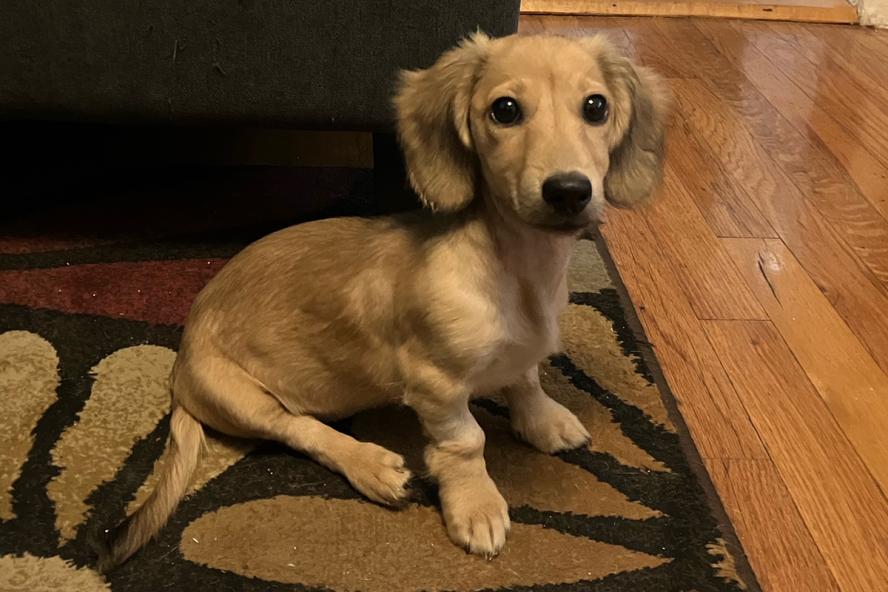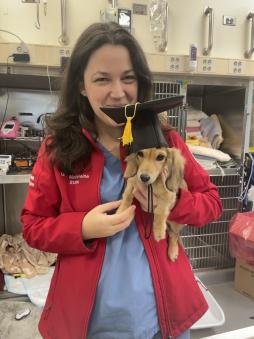-
About
- Leadership & Faculty
- News & Events
-
Academics
- Graduate
- Advanced Clinical Training
- Continuing Education
- Academic Departments
- Academic Offices
- Simulation Experiences
-
Student Life
- Offices
-
Research
-
Hospitals & Clinics
- Emergency Care
- Hospital Services
-
Community Outreach
- Volunteer
A Mini Miracle
Four-pound dachshund saved by treatment on new extracorporeal therapy machine

Earlier this year, Cummings School of Veterinary Medicine at Tufts University became the first veterinary school in the country to obtain a unique dialysis machine, which provides renal replacement therapy for acute kidney injury and fluid-overloaded patients weighing 2–10 kgs (4–22 lbs).
In late September, shortly after providing extracorporeal treatment to its 400th patient since its service began in 2000 at Henry and Lois Foster Hospital for Small Animals, Cummings School used the new machine on its smallest patient, a 14-week-old dachshund. Winnie weighed four pounds.
Designed for humans, the system is used by just 14 children’s hospitals across the country, according to Dr. Mary Labato, V83 (she/her), a veterinary internist at Foster Hospital and Cummings School’s Anne Engen and Belle Professor in Clinical Nephrology. In addition to Cummings School, only a veterinary private practice near Washington, D.C., has this new system. “We are fortunate to offer this to our most diminutive patients, which could include small cats, ferrets, or other exotic species,” says Labato.
Winnie’s owners, Jessica Redon (she/her) and Eric Reseland (he/him), brought her to a Boston animal hospital because she had vomited, was lethargic, and had difficulty urinating for a couple days. “She was dehydrated,” Reseland says. “So, they admitted her, gave her fluids, and ran some tests. Her kidney function was atrocious.”
Winnie had contracted leptospirosis, an infectious disease that is caused by contact with urine from infected animals or through water, soil, or food contaminated with their urine. Without treatment, it can lead to kidney and liver damage and, in the most severe cases, death.
When she did not produce any urine at the hospital, Jessica and Eric were told that dialysis would be her only chance to survive, and they were referred to Cummings School.
Jessica and Eric were relieved to find that with the proper treatment, Winnie’s life could be saved. Foster Hospital’s Dr. Madeleine Stein (she/her), an internal medicine resident, served as the primary doctor on the case, while dialysis technician Carolyn Tai helped administer and monitor her treatments.
“When we first arrived, Dr. Stein and Carolyn explained Winnie’s condition and how the new machine would work on a dog her size,” Reseland says.
“She was so young that she hadn’t gotten the leptospirosis vaccine,” says Dr. Emmanuelle Butty (she/her), the clinical assistant professor supervising the case. “It’s not a perfect vaccine, but the hope is it will lessen the severity of the disease.
“Her kidney values were constantly increasing, and that signaled they were shutting down. Winnie needed dialysis because without the treatment, she would die from her own toxins.” Dialysis takes over the role of the kidneys and offers the patient time for its kidneys to heal.
According to Butty, due to the size of the patient, these are extremely difficult cases to handle. “But this machine is extremely precise for how much toxin we remove from the blood during the process and adapts to the size of each patient,” she says.
Fortunately, the successful procedure gave Winnie a second chance. “She needed a session every day, then every other day, until her kidneys recovered to produce urine on their own. Since her liver and coagulation status were also affected, it took two weeks in the hospital to recover,” says Butty.
“Dr. Stein and the team kept in touch with updates every day,” Redon explains. “They were super. No matter who we talked to when we visited the hospital, everyone knew Winnie. I don’t think we could have asked for better service, throughout her stay.”
Department:
Foster Hospital for Small Animals
